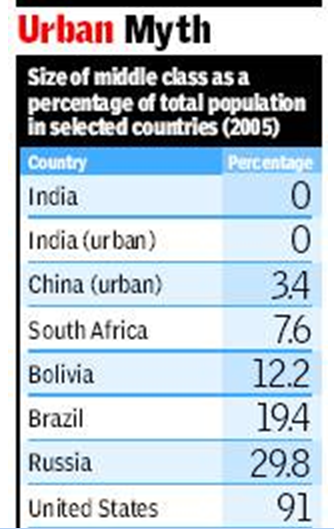Middle class: India
This is a collection of articles archived for the excellence of their content. Readers will be able to edit existing articles and post new articles directly |
Points of view
India has no middle class
‘Those Earning Over $10 A Day Constitute The Top 5%’ Rukmini Shrinivasan
New Delhi: Could the Great Indian Middle Class be the Great Indian Mythical Class? A proposed new international definition of what constitutes the middle class in a developing country has thrown up a startling conclusion by global standards, India has no middle class.
Noted economist Nancy Birdsall, president of the Center for Global Development, has proposed a new definition of the middle class for developing countries in a forthcoming World Bank publication, Equity in a Globalizing World. Birdsall defines the middle class in the developing world to include people with an income above $10 day, but excluding the top 5% of that country. By this definition, India even urban India alone has no middle class; everyone at over $10 a day is in the top 5% of the country.
This is a combination both of the depth of India’s poverty and its inequality. China had no middle class in 1990, but by 2005, had a small urban middle class (3% of the population). South Africa (7%), Russia (30%) and Brazil (19%) all had sizable middle classes in 2005.
While many economists have in the past as well attempted to define the middle class, Birdsall puts into monetary terms the broader concept of what a middle class really is, as opposed to merely counting the middle third of a country. In socio-political terms, the middle class is traditionally that segment of society with a degree of economic security that allows it to uphold the rule of law, invest and desire stability. They do not, unlike those defined as rich, depend on inheritances or other non-productive sources of income.
Birdsall argues that while the equivalent of $10 per day in 2005 as a lower limit is on the low side by the standards of industrialized countries, somewhere around $10 a day per person household members are able to care about and save for the future and to have aspirations for a better life for themselves as well as their children because they feel reasonably secure economically. OECD countries define their poverty lines as 50% of median income which works out in Purchasing Power Parity (PPP) terms to about $30 day. In US the poverty line for a single individual in 2008 was $29 per day and for each individual in a four-person household was about $14 per day.
However, people in developing countries living on even $10 a day still have extremely low social indicators. Economist Lant Pritchett has shown that infant mortality of households in the richest quintile in Bolivia was 32 and Ghana 58 per 1,000. Fewer than 25% of people in the richest quintile in India complete 9 grades of school, Pritchett showed. “An upper limit of the 95th percentile, while on the high side, is just about sufficient to exclude the countrys richest,” Birdsall adds.

